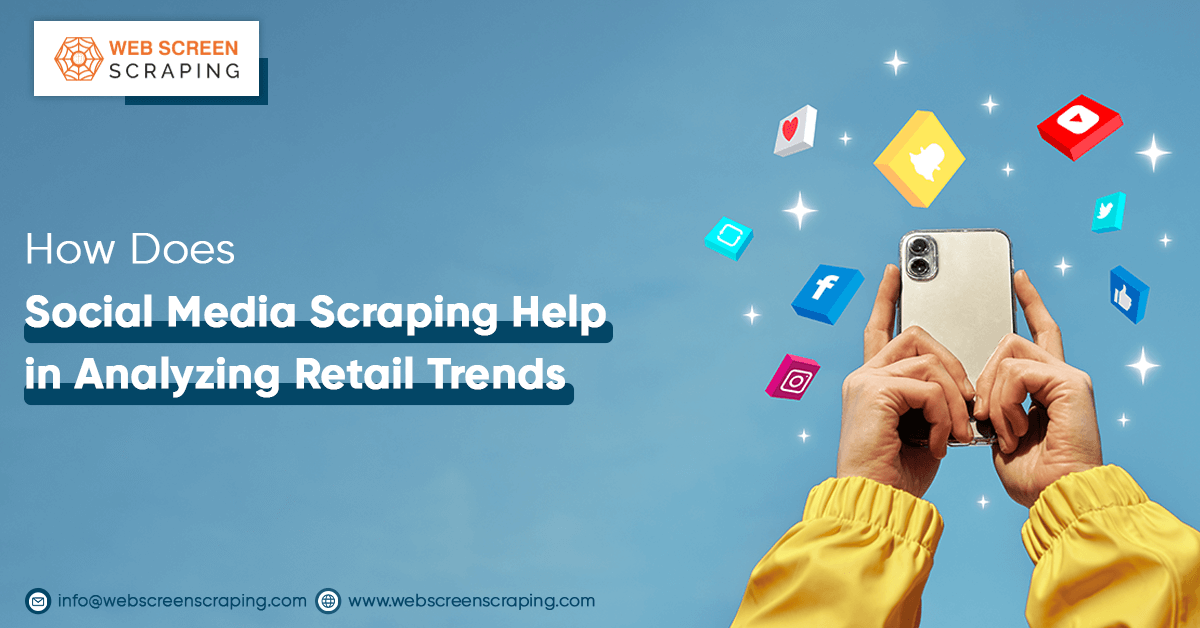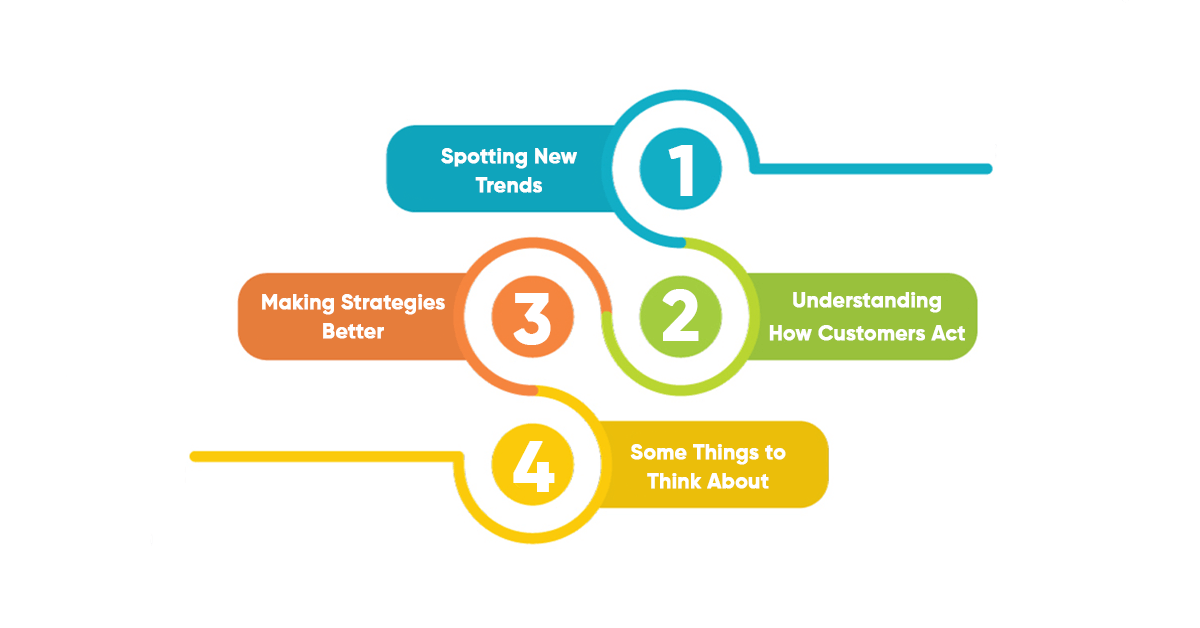
In today's fast-changing retail landscape, staying up-to-date with what is in demand is critical to success. Social media has become an invaluable resource for knowing what people want, how they behave, and how they feel. Scraping social media data is one approach used to acquire this information, which has proven highly significant in predicting retail trends.
Think of social media as a huge marketplace where people talk openly about what they like, their experiences, and what they buy. By scraping these platforms, retailers get access to tons of real customer info, like what products they prefer, what they think of different brands, and what's becoming popular.
What is Social Media Scraping?
Social media scraping is about gathering data from social platforms like Facebook, Twitter, Instagram, and LinkedIn. This data includes things like posts, comments, likes, followers, and more. The goal is to gather a lot of information to analyze trends, feelings, behaviors, and other useful insights.
There are a few methods for social media scraping:
API Access
Some social media sites offer APIs that let developers get data in a structured and authorized way. APIs have rules and limits set by the platform.
Web Scraping
Web scraping steps in when APIs don't provide enough data or are unavailable. This means writing scripts or using special software to grab data straight from social media pages' HTML code.
Social media scraping is big in many industries, like marketing, research, customer service, and keeping an eye on the competition. By looking at the data they scrape, businesses can learn about what customers like, how they feel about brands, what's new, and what rivals are up to. For market research, social media scraping acts like a virtual focus group, providing real-time consumer feedback and honest opinions. Researchers can use scraped data to spot trends, track changing consumer sentiments, and measure the impact of marketing efforts. Armed with these insights, businesses can adjust their offerings to match evolving consumer demands, ensuring they stay relevant and competitive.
In customer service, social media scraping enables firms to respond to problems quickly and increase customer satisfaction. Monitoring social media mentions and sentiment allows businesses to swiftly discover and rectify issues, reply to questions, and promote favorable remarks. In an era when customer experience is critical, this proactive strategy fosters loyalty and protects brand reputation.
However, scraping comes with responsibilities that must be followed to ensure safe and ethical data scraping activities. There are ethical and legal issues, especially around user privacy and data rights. Businesses need to follow the rules and respect the terms of service of the social media platforms they're scraping. It is also essential to be open and get permission from users when collecting and using their social media data for analysis.
How to Know Retail Industry Trends Using Social Media Data Scraping?

Social media data scraping can help stores understand what's hot and what's not in their industry. Here's how it works:
Spotting New Trends
By checking out what people are talking about on social media, stores can see which products and features are getting a lot of attention. This helps them stay on top of new trends. Stores can also use social media to see how customers are reacting to trends. Are they loving something or not so much? This information helps stores decide whether to jump on a trend or let it pass. Social media scraping can also help stores find influencers who speak to their audience. Working with these influencers can help stores promote new stuff.
Understanding How Customers Act
By looking at what people are saying about certain products or brands on social media, stores can learn what customers prefer, what they don't, and what they want more of. Social media data helps stores see how customers go from spotting a product online to buying it. This helps stores make their online shopping experience better. Stores can use social media scraping to see what people are saying about their competitors. This helps them see what's working for others and what isn't.
Making Strategies Better
Social media scraping gives stores information about their customers. This helps stores make ads and posts that reach the right folks. When stores know what customers like, they can make ads and suggestions that feel more personal, which makes customers more likely to buy stuff. Social media scraping also helps stores spot when customers are unhappy. Then, stores can fix the problem fast and keep customers happy.
Some Things to Think About
Stores need to play by social media rules and respect people's privacy. There's a lot of info to deal with from social media. Stores need to store it safely, process it well, and use it smartly. Social media scraping can be a big help for stores, but it's essential to do it the right way. With this info, stores can keep up with what's happening in their industry, understand their customers, and make better plans for the future.
Retail Use Cases of Social Media Data Scraping
Social media data scraping can really help stores understand what's hot and what's not in their industry.
Market Analysis
Social media scraping enables shops to understand market trends thoroughly. By monitoring what people are saying on social media, businesses may learn a lot about what their customers want and how they feel. This allows retailers to stay up with what's popular, what customers want, and what's going on with brands and items.
With all of this information, shops may tailor their products and marketing to suit their customers' preferences better. For example, if enough people express a desire for more environmentally friendly products, retailers can begin stocking them and promoting their green efforts in their advertisements.
Competitor Research
In the retail industry, knowing what your competitors are doing is critical. Social media scraping allows retailers to keep track of their competitors' activities. They can see the products they're promoting, what promotions they're offering, and how buyers are responding.
For example, if a competitor debuts a new product and it receives a lot of attention on social media, stores can take note and even change their own plans accordingly. And if customers complain about what a competitor is doing, retailers can intervene and provide a better alternative.
Trend Identification
In a fast-paced market, being able to jump on new trends early can give stores a big advantage. Social media scraping helps stores do just that by watching what people are talking about. By monitoring hashtags, keywords, and discussions, stores can see what's starting to catch on. Then, they can adjust their products and marketing to match. For example, if a certain product category is getting lots of buzz on social media, stores can start thinking about adding similar products to their lineup or adjusting their ads to discuss that trend.
Predictive Analytics
Using social media data allows businesses to predict what their customers will do next, identify industry trends, and understand what they want to buy. By analyzing previous social media content and trends, retailers can make informed decisions and predict what can happen in the future, allowing them to be prepared and respond quickly in a changing retail landscape. In short, scraping social media data is extremely beneficial for businesses. It allows them to learn about what their customers like, monitor how people perceive their brand, research their competitors, identify trends, collaborate with influencers, speak with customers, and forecast what will happen next. Retailers may learn much using social media data, make better judgments, and remain ahead.
Improving Customer Service
Good customer service is key to doing well in retail. Social media scraping helps stores make their customer service even better. By using this tech, stores can keep an eye on what customers are saying, whether it's feedback, complaints, or questions, on different social media sites, and they can do it right away.
This smart approach lets stores deal with customer problems quickly and offer personalized help, improving the whole shopping experience. For example, if a customer isn't happy with a product and posts about it on social media, stores can jump in quickly to fix the issue or help out.
Conclusion
Social media data scraping is radically changing how businesses navigate and capitalize on developing trends in the retail sector. By leveraging the vast amount of data available on social media platforms, merchants gain priceless insights into consumer behaviors, market dynamics, and competitor tactics.
This plethora of data serves as the foundation for educated decision-making, allowing businesses to effectively anticipate changes in consumer preferences and market trends. Armed with this information, retailers can strategically reinvent their product offers, modify their marketing strategies, and position themselves as industry leaders in the fast-paced retail environment.

